Midterm Study Guide RNR 3018
Most Important topics
Evolutionary relationships (phylogeny- be able to draw a tree, not the old-school diagram from the beginning of each lecture)
A phylogenetic tree is a diagram that represents evolutionary relationships among organisms. Phylogenetic trees are hypotheses, not definitive facts.
The pattern of branching in a phylogenetic tree reflects how species or other groups evolved from a series of common ancestors.
In trees, two species are more related if they have a more recent common ancestor and less related if they have a less recent common ancestor.
Phylogenetic trees can be drawn in various equivalent styles. Rotating a tree about its branch points doesn't change the information it carries.
Each branch point (also called an internal node) represents a divergence event, or splitting apart of a single group into two descendant groups.
At each branch point lies the most recent common ancestor of all the groups descended from that branch point.
Key evolutionary innovations and where they can be placed on the phylogeny
Amphibians
Amphibians, which evolved about 365 million years ago from a lobe-finned fish ancestor, have undergone several key evolutionary innovations:
Development of Limbs: Amphibians were the first group of vertebrates to develop limbs, enabling them to leave the water and conquer the land.
Lungs: The sarcopterygian ancestor of amphibians possessed lungs, which provide the ability to breathe air. This trait appeared in bony fishes well before the fish-tetrapod transition.
Metamorphosis: Amphibians typically start out as aquatic larvae with gills known as tadpoles. The young generally undergo metamorphosis from larva with gills to an adult air-breathing form with lungs.
Skin Respiration: Amphibians use their skin as a secondary respiratory surface and some small terrestrial salamanders and frogs lack lungs and rely entirely on their skin.
In terms of phylogeny, amphibians are a paraphyletic group encompassing all tetrapods, excluding the amniotes (tetrapods with an amniotic membrane, such as modern reptiles, birds, and mammals). All extant (living) amphibians belong to the monophyletic subclass Lissamphibia, with three living orders: Anura (frogs), Urodela (salamanders), and Gymnophiona (caecilians). The earliest amphibians evolved in the Devonian period from sarcopterygian fish with lungs and bony-limbed fins, features that were helpful in adapting to dry land. They diversified and became ecologically dominant during the Carboniferous and Permian periods, but were later displaced in terrestrial environments by early reptiles and basal synapsids (mammal predecessors). The origin of modern amphibians belonging to Lissamphibia, which first appeared during the Early Triassic, around 250 million years ago, has long been contentious. However, the emerging consensus is that they likely originated from temnospondyls, the most diverse group of prehistoric amphibians, during the Permian period.
Reptiles
Reptiles, which first arose about 320 million years ago during the Carboniferous period, have undergone several key evolutionary innovations:
Development of Lungs and Legs: These are the main transitional steps towards reptiles.
Hard-Shelled External Eggs: The development of hard-shelled external eggs replacing the amphibious water-bound eggs is the defining feature of the class Reptilia and is what allowed these amphibians to fully leave water.
Scales or Scutes: Reptiles are defined as animals that have scales or scutes.
Ectothermic Metabolisms: Reptiles possess ectothermic metabolisms.
The evolution of these features did not occur in a single major evolutionary event, but rather through many small bursts of morphological changes over a period of 50 million years.
In terms of phylogeny, reptiles are a paraphyletic group comprising all non-avian and non-mammalian amniotes. The two largest lineages of reptiles, Archosauromorpha (crocodilians, birds, and kin) and Lepidosauromorpha (lizards, and kin), diverged near the end of the Permian period. The earliest known proto-reptiles originated around 312 million years ago during the Carboniferous period5. The earliest known eureptile (“true reptile”) was Hylonomus.
Mammals
Mammals, which first appeared during the late Carboniferous period, have undergone several key evolutionary innovations:
Differentiated Teeth: Mammals developed differentiated teeth with precise occlusion, which was crucial for capturing arthropods and crushing their exoskeletons.
Hard Palate: The development of a hard roof of the mouth created a dedicated airway to the lungs, allowing mammal ancestors to eat and breathe at the same time.
Spine Structure: The change from a spine that bends from left to right to one that enables bending up and down ultimately allowed mammals to take in more oxygen as they moved, helping them run faster.
Variety of Tooth Shapes: The variety of tooth shapes — incisors, canines, premolars, and molars — made it possible for mammals to eat many kinds of food.
Milk Production, Warm-Bloodedness, Hair: These are very familiar mammalian characteristics.
Jaw Joint: A joint in the jaw that makes chewing possible was a major evolutionary turning point.
Middle Ear Bones: The transformation of two bones in the reptile jaw, which migrated to the middle ear to become two members of a famous trio, the hammer and anvil.
In terms of phylogeny, mammals are a part of the synapsid lineage, which became distinct from the sauropsid lineage in the late Carboniferous period, between 320 and 315 million years ago. The only living synapsids are mammals. The lineage leading to today’s mammals split up in the Jurassic; synapsids from this period include Dryolestes, more closely related to extant placentals and marsupials than to monotremes, as well as Ambondro, more closely related to monotremes. Later on, the eutherian and metatherian lineages separated; the metatherians are the animals more closely related to the marsupials, while the eutherians are those more closely related to the placentals. Since Juramaia, the earliest known eutherian, lived 160 million years ago in the Jurassic, this divergence must have occurred in the same period.
Take home messages-
3 old clades:
monotremes
marsupials
eutherians
Major eutherian clades
present by late
Cretaceous
Eutherian diversification
after K-Pg extinctions
Birds
Birds, which evolved from theropod dinosaurs about 150 million years ago during the Jurassic period, have undergone several key evolutionary innovations:
Feathers: The evolution of feathers is a key innovation in birds. They provide insulation, enable flight, and are used in display and camouflage.
Beak: The bird beak is a key evolutionary innovation that allowed birds to diversify into a range of ecological niches.
Powered Flight: The ability for powered flight is a major evolutionary innovation in birds.
Respiratory System: Birds have a unique respiratory system that is highly efficient and adapted for flight.
In terms of phylogeny, birds are the only living descendants of dinosaurs. They evolved from a group called the theropod dinosaurs that included bipedal carnivores such as Tyrannosaurus rex and Velociraptor. Birds are deeply nested within the theropod phylogeny. The earliest bird known is Archaeopteryx, which had features of both birds and reptiles. Modern phylogenies place birds in the dinosaur clade Theropoda. According to the current consensus, Aves and a sister group, the order Crocodilia, together are the sole living members of an unranked reptile clade, the Archosauria. Four distinct lineages of bird survived the Cretaceous–Paleogene extinction event 66 million years ago, giving rise to ostriches and relatives (Palaeognathae), waterfowl (Anseriformes), ground-living fowl (Galliformes), and “modern birds” (Neoaves).
Skeletal features, particularly skulls
Amphibians
Salamander skeleton
Short neck (1 vertebra)
Short ribs along entire trunk
Little modification for attachment of pelvis to vertebral column
Frog skeleton
Adult frog skeleton modified from the amphibian plan-
Much reduced trunk
No tail
Modified pelvis and hindlimb
Reptiles
The jaws of reptiles are equipped with various adaptations, such as the movable quadrate bone in snakes and the kinetic skull of lizards.
Some reptiles, like turtles, have a unique bony shell that encases both the skull and the rest of the body.
Order Crocodylia- Crocodilians
Primitive trait:
no cranial kinesis (or is this secondary?)
Derived trait:
skull openings for muscle attachment
teeth in deep bony sockets
Discreet neck (as in all reptiles)
Ribs only on the thorax
Vertebral column not modified for pelvis
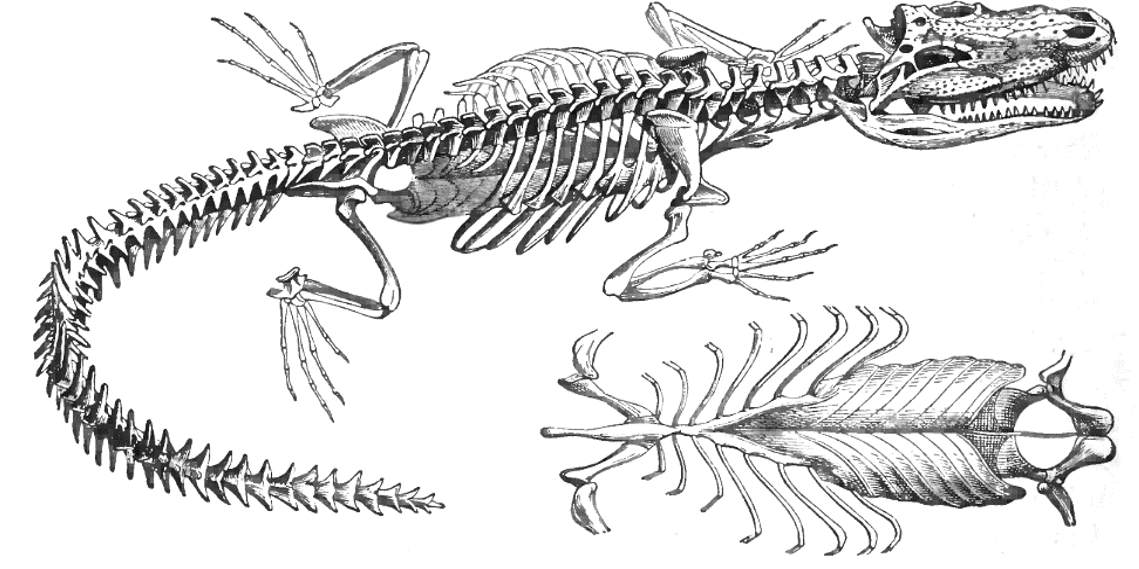
Order Testudines- Turtles
Primitive traits:
no skull openings for jaw muscle attachment
no cranial kinesis
Derived trait:
teeth lost
Tuatara, lizards, and snakes
Derived trait in tuatara
skull openings for jaw muscles
Derived trait in squamates
kinetic quadrate
Additional derived trait in snakes
kinetic upper jaw
Snakes have long neck and rib bones unlike amphibians
Definitions
Cranial kinesis refers to the ability of an animal’s skull to move relative to its braincase or other skull components.
Unlike humans, whose skulls are relatively rigid, animals with cranial kinesis exhibit flexibility and mobility in their skull structures.
Birds
Modern bird skeleton shows reptilian features and unique avian features -The avian features are modifications for flight.
No teeth - saves weight
Dinosaur skull
Modified hand and wrist
Giant sternum for attachment of flight muscles
Reduced tail- saves weight
Dinosaur pelvis
Bird bones are also hollow to save weight
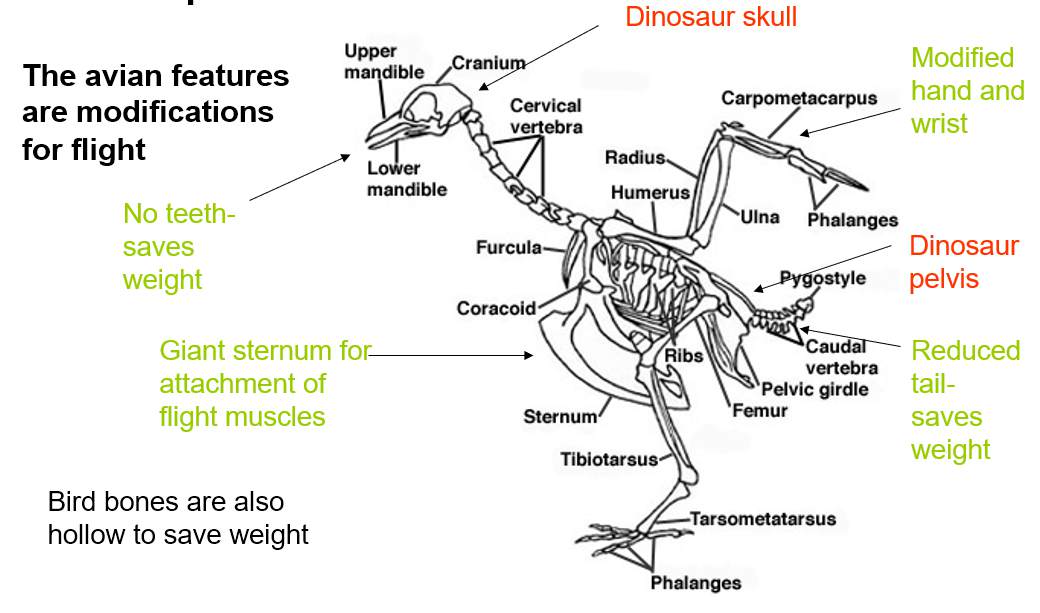
Mammals
The path from reptiles to mammals- about 250 mybp.
This animal is in Therapsida, a clade that includes mammals.
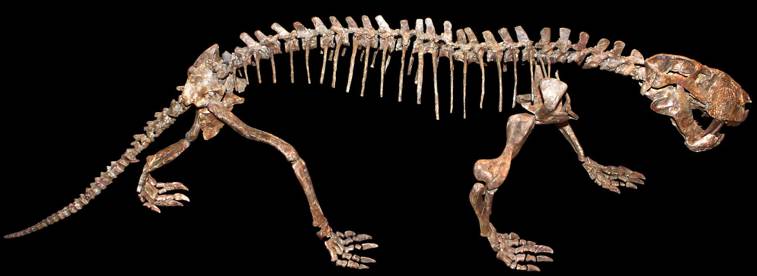
Reptilian vertebral column and ribs
Mammalian limb orientation- under the trunk
Mammalian and reptilian skull characteristics
Mammalian skull characteristics:
Zygomatic arch
Coronoid process of dentary
Heterodont dentition
Reptilian skull characteristic:
Jaw articulation at the rear of the jaw on the articular
Evolution of the mammalian jaw
Appearance of heterodont teeth, some with multiple roots
Loss of jaw bones (articular moves to the middle ear, only dentary remains)
Enlargement of coronoid process
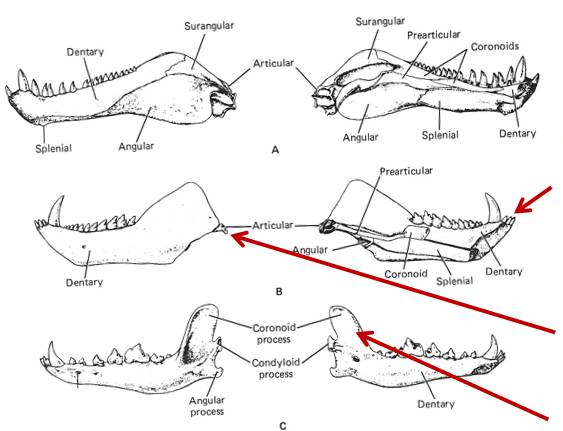
Names of the important families (amphibians, reptiles, rodents) and orders (mammals, birds) in Louisiana
Amphibians
Order: Caudata (salamanders)
Families:
Ambystomatidae (mole salamanders; mostly subterranian)
Amphiumidae (amphiumas; aquatic, large)
Plethodontidae (lungless salamanders; nasolabial groove)
Proteidae (mudpuppies & waterdogs; aquatic)
Salamandridae (newts)
Sirenidae (sirens)
Order: Anura (frogs & toads)
Families:
Bufonidae (toads)
Hylidae (treefrogs & allies)
Eleutherodactylidae (tropical frogs; no tadpole stage)
Microhylidae (narrow-mouthed toads & allies)
Ranidae (true frogs)
Scaphiopodidae (spadefoots)
Reptiles
Order: Crocodylia (crocodiles and alligators)
Family: Alligatoridae (alligators & caimans; short, wide heads)
Order: Testudines (turtles)
Families:
Cheloniidae (sea turtles)
Chelyridae (snapping turtles)
Dermochelyidae (leatherback)
Kinosternidae (musk and mud turtles)
Emydidae (box and water turtles)
Testudididae (tortoises)
Trionychidae (softshells)
Order: Squamata (lizards & snakes)
Families:
Anguidae (glass lizards)
Dactyloidae (anoles)
Gekkonidae (geckos)
Phrynosomatidae (horned lizards, Prarie Lizard and allies)
Scincidae (skinks)
Sphenomorphidae (forest skinks)
Teiidae (whiptails)
Colubridae (colubrid snakes)
Dipsadidae (rear-fanged snakes)
Elapidae (coral snakes & many other venomous allies)
Natricidae (harmless live-bearing snakes)
Typhlopidae (blind snakes)
Viperidae (vipers)
Birds
Orders:
Anseriformes (Waterfowl)
Galliformes (Game birds)
Gaviiformes (Loons)
Podicipediformes (Grebes)
Procellariformes (Seabirds)
Ciconiiformes (Wood Stork)
Suliformes (Cormorants, boobies, anhinga)
Pelecaniformes (Pelicans, herons, ibis)
Accipitriformes (Vultures, hawks, Osprey)
Gruiformes (Cranes & rails)
Charadriiformes (Shorebirds & gulls)
Columbiformes (Doves & pigeons)
Cuculiformes (Cuckoos, roadrunner, ani)
Strigiformes (Owls)
Caprimulgiformes (Poor-wills & nightjars)
Apodiformes (Swifts & hummingbirds)
Coraciformes (Kingfishers)
Piciformes (Woodpeckers)
Psittaciformes (Parrots)
Falconiformes (Falcons and caracara)
Passeriformes (Perching birds)
Mammals
Orders:
Didelphimorphia (opossums)
Cingulata (armadillos)
Sirenia (manatees, dugongs)
Artiodactyla (even-toad ungulates, whales)
Chiroptera (bats)
Eulipotyphla (shrews and moles)
Carnivora (carnivores)
Canidae (dogs)
Felidae (cats)
Mephitidae (skunks)
Mustelidae (weasels, otters)
Procyonidae (raccoons, coatis)
Ursidae (bears)
Rodentia (rodents)
Castoridae (beaver)
Geomyidae (pocket gophers)
Heteromyidae (pocket mice)
Cricetidae (New World rats and mice)
Muridae (Old World rodents)
Echimyidae (nutria and spiny rats)
Sciuridae (squirrels, chipmunks)
Lagomorpha (rabbits, hares, pikas)
Primates (monkeys, apes)
Recognition of classification levels (e.g. knowing how orders and families are written)
See Correct use of taxonomy and lists
Basic biology of the different groups, depending on what was emphasized in lecture
General characteristics of amphibians
Glandular skin produce toxins and mucous (highly variable among species)
True middle ear with columella (transmits vibrations for hearing- also in reptiles and birds)
One neck vertebra (no neck vertebrae in fish, multiple in amniotes)
No dermal bone (a fish trait- fish scales are dermal bone)
No claws (an amniote trait)
Eggs cannot resist desiccation
Highly variable respiration- lungs, gills, skin
General characteristics of reptiles
Specialized neck vertebrae
All breathe with lungs
Keratinized epidermal scales and claws
Internal fertilization
Amniote egg (or live birth)
Strong olfaction
Some return to marine life (no amphibians are marine)
Some with temperature dependent sex determination
American Alligator - biology is typical of crocodilians
Endemic to SE US
May reach >5 m and live >50 years (!)
Apex predators
Nest on mounds in marsh vegetation
Winter in deep holes dug laterally into banks
Nest temperature determines sex (warmer -> males)
Females guard nests
Communicate vocally
Turtle Biology
Lay eggs on land
Usually no parental care
Unusual life history with high adult survival and very low survival before adulthood
Bony shell usually covered with keratinized epidermal scutes that are periodically shed (except softshells and leatherback)
Bony shell plates fused to ribs and vertebrae
Eat plant and animal material
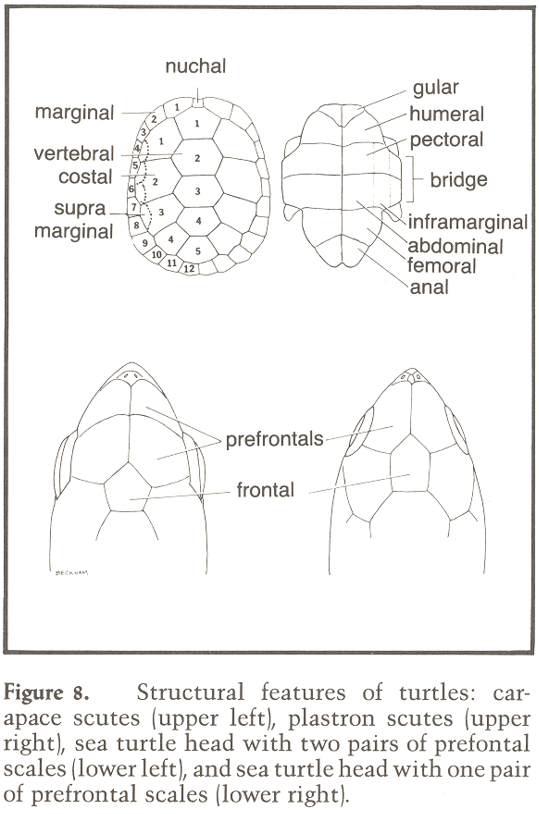
Lizard Biology
External ears (lacking in snakes), but rarely communicate vocally
No LA lizards are aquatic
Most lizards (all LA lizards) lay eggs, either one at a time (anoles) or clutches of up to 50
Some lizards (e.g. skinks) show parental care of eggs, others (e.g. anoles) do not
All LA lizards eat animal prey
Snake Biology
Highly modified jaws and skull
Diverged from lizards ~100mya (?)
Some with vestigial pelvis
Live bearing or egg laying
Eat animals only
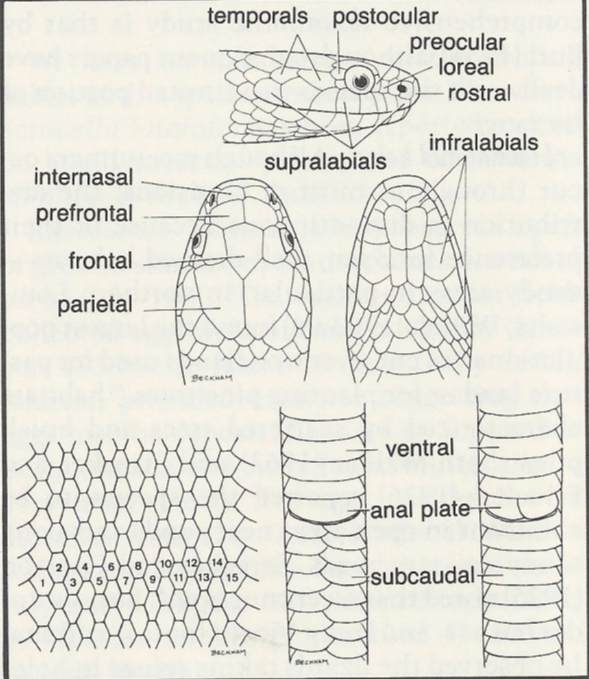
Bird Stuff
4 chambered heart- separates blood with oxygen from blood without oxygen
Endothermy (warm-blooded)-
allows fast metabolism at any environmental temperature
Oviparity- lay eggs one at a time
No urinary bladder
Muscular gizzard- replaces teeth to grind food
Short gut
Large brain
Excellent vision
These are traits related to:
high mobility
high energy requirements
diurnal activity
Characteristics of mammals
Uniquely modified skull (jaw, ear, zygomatic arch)
Heterodont dentition
Specialized skeleton, especially feet
Hair (another type of keratinized epidermis)
Dermal muscles
Mammary glands (and other skin glands)
Endothermy
Skin glands unique to mammals
Mammary glands – provide nourishment for young during postnatal growth (milk stimulated by endocrine system)
Sweat glands – promotes evaporative cooling and eliminates waste – typically restricted in location
Sebaceous glands – secretions lubricate hair and skin
Hair (also called pelage)
Keratin-based product of epidermis
Critical for endothermy
Pelage patterns important for communication or crypsis
Hair oriented by dermal muscles
Endothermy- Circulatory system
Complete separation of systemic and pulmonary circulation (4 chambered heart, 2 chambers receive blood and 2 pump blood)
Many mammals can alter heart rate
Hibernation
Carnivore lethargy, alarm bradycardia (‘freezing’)
Bats – resting and active heart rates differ by 500 beats per minute, and change within 1 second
Only in endotherms, with high oxygen demand, is it critical always to separate oxygenated blood (coming from the lung) from deoxygenated blood (coming from the body’s capillary beds)
Endothermy- Fat and energy storage
Not unique to mammals, but important for energy storage, source of heat and water, and insulation
Temperate mammals typically have localized fat storage
Boreal and aquatic species store fat subcutaneously over the body
Endothermy- Respiratory system
Diaphragm – unique to mammals
Heart and particularly lungs are large relative to body surface- required for endothermy
Exchange of gases occurs via alveoli, where oxygen enters bloodstream
Lung surface- humans have 70 m2 of lung surface, about 40 times the surface area of the body
Biology of venomous snakes in Louisiana
Family Viperidae
~250 species worldwide except Australia
Derived venom-injecting through elongated hollow fangs
Hemotoxic venom – local tissue damage
Loreal pits detect heat to 0.2 degrees C
Vertically elliptical pupils in North American viperids
Triangular head
Biology of the annual cycle in birds
Annual cycle - Most birds exhibit an annual reproductive cycle, which includes stages such as breeding, nestling/fledgling, molt, migration (for migratory species), and non-breeding (refractoriness).
breeding
molt
migration
molt
migration
Regulation of cycle
Photoperiod
Photoperiod refers to the duration of daylight or the length of time that a bird is exposed to natural light during a 24-hour period. It plays a crucial role in regulating various physiological processes in birds, particularly their reproductive cycles.
What about ducks?
Long distance migrants have relatively fixed timing of migration
Short distance migrants (like ducks, or robins) may show variation within the migration period due to local conditions- but they still respond to photoperiod
Timing of breeding
latitudinal variation
variation among species
Timing of breeding is an evolved response to match food availability to energy needs of reproduction
Breeding duration is more narrow at higher latitudes and higher elevations
Variation among species is greatest in the tropics, least at high latitudes
Migration - predictable seasonal movements (most migrants)
Nomadism - unpredictable aseasonal movements (rare in temperate zone)
Facultative migration - a combination (American Robins, ducks)
Evolution of migration
Migration route reflects evolutionary history of the species
Migration can evolve rapidly or disappear
Timing is changing with global climate change
The sexes within a species often differ in winter distribution or timing of migration
Physiology
Hyperphagy - migratory fattening - innate
varies with distance to travel and barriers to cross
stopover sites can be critically important
Zugunruhe - nocturnal restlessness - innate
varies with distance to travel
Speeds- 25-50 km/hour, plus tailwinds
Range- up to 9 days straight (usually >12 h for Gulf crossing)
Daily timing of migration
Hawks, swallows, swifts - by day
Cuckoos, hummingbirds, most songbirds - by night
Shorebirds and waterfowl - day or night
Why these differences?
Different bird species occupy distinct ecological niches and habitats. Their feeding preferences, nesting requirements, and foraging strategies vary significantly.
Food availability
Photoperiod and Circadian Rhythms
Evolutionary History and Genetics
Navigation - How do they know where they’re going?
homing vs migration
Homing is the ability of certain animals to return to a specific place when displaced from it, often over great distances. This behavior can occur in any compass direction and at any season. Homing is usually associated with shorter distances and shorter periods of time, often daily, and typically involves a return to a home base after a journey in search of food or mates.
Migration, is the regular, repeated mass movement of animals for breeding or avoidance of climatic extremes. It usually involves longer distances and longer periods of time.
Visual landmarks - important for local movements
Celestial navigation - sun, stars
Sun compass - use position of the sun for direction (requires an internal clock)
Geomagnetism (magnetic fields)
Olfaction - mostly used for local movements
learning
Birds have well defined annual cycles
All birds:
Breeding
territory establishment (singing)
courtship
nest construction
egg laying and incubation
care of nestlings and fledglings
Molt
Migratory birds:
Migration to wintering grounds
Molt (usually just body feathers)
Migration to breeding grounds
Describing dentition in mammals (dental formula)
Dentition and dental formulas
I = incisor
C = canine
P = premolar
M = molar
(U = upper, L = lower)
The numbers are read as how many of either incisors, canines, premolars, or molars. It is read in that order as well.
For example,
U 5 1 3 4 26 ← This is the upper row. It is saying that there are 5 incisors, 1 canine, 3 premolars and 4 molars on each side of the mouth, so there is 26 in maxillary.
L 4 1 3 4 24 ← This is the lower row. It is saying that there are 4 incisors, 1 canine, 3 premolars, and 4 molars, and there is 24 in the mandibular totaling 50 in all Didelphis (opossums)
(Fun fact! The term, "maxillary", is given to teeth in the upper jaw and "mandibular" to those in the lower jaw.)
Inferring diet and taxonomy from dentition in mammals
In Canidae, the carnassial tooth in canids is a premolar on the maxillary and a molar on the mandible.
Ungulates are highly specialized for plant diet:
Often lose upper incisors
Usually lose canines
Long, flat molars and premolars with irregular surfaces
Armadillo skull- bizarre (As are all Xenarthra skulls- anteaters, sloths)
Armadillo have peg-like teeth. These peg-like, single-rooted teeth are often not classified as incisors etc:
U 0 0 { 8 } 16
L 0 0 { 8 } 16 = 32 Dasypus
Hispid Cotton Rat skull- typical rodent
Highly derived- loss of lots of teeth
Elongated incisors
No canines or premolars
Few broad molars
U 1 0 0 3
L 1 0 0 3
Key aspects of the Earth’s history relevant to modern patterns of diversity
Moderately important topics:
LA vs worldwide diversity, particularly amphibians, reptiles, and mammals
Bird orders in bold
Broad geographic patterns of breeding periods in birds
Evolution and extreme examples of migration in birds
Mammal legs and feet
Diversity of reproductive physiology in mammals
Less important topics:
Turtle families
Biology of individual species from the mammals lecture (except to illustrate general traits)
Characters useful for id but not evolutionarily meaningful (e.g. illustrations of scale patterns)
Family or order names and details for taxa with few LA species unless they were emphasized (e.g. Crocodylia is important, Sirenidae is not)
Mechanics of flight
ID of birds based on feet or bills
Navigation cues